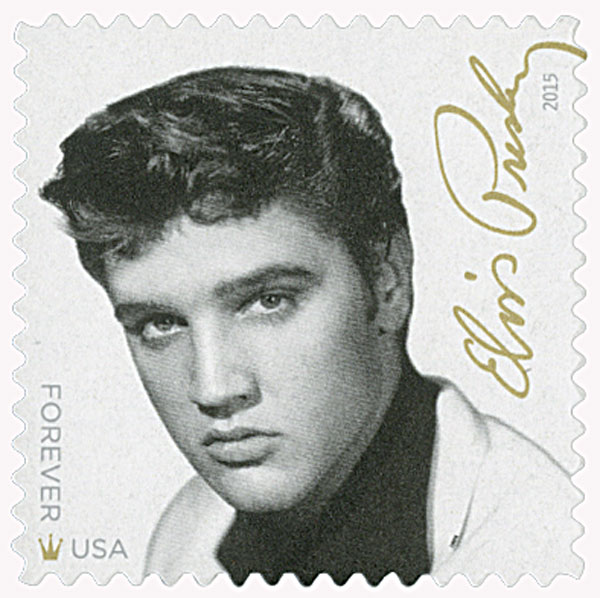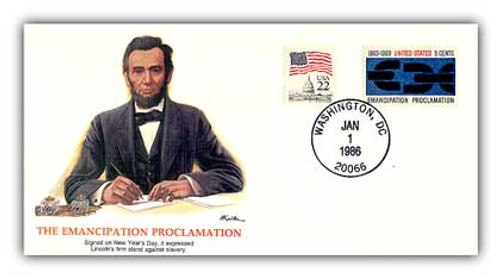
# 81565 - 1985 Epic Events in American History - Salk Polio Vaccine Deluxe Cover
Dr. Jonas Salk
Jonas Edward Salk was born on October 28, 1914, in New York, New York.
Salk attended the Townsend Harris High School for gifted students and had a reputation for being a perfectionist. He would also read anything he could get his hands on.
From there Salk went on to attend the City College of New York where he earned a degree in chemistry in 1934. He had originally wanted to study law, and claimed he never had an interest in science as a child, but his mother urged him to pursue medicine. Salk then went to New York City Medical School. However, he didn’t want to study medicine, rather he preferred medical research.
Salk soon focused his studies on bacteriology. He stated that he wanted to help humankind as a whole, instead of single patients. Salk was particularly influenced by his time in the laboratory of Thomas Francis, who studied the influenza virus. He helped develop the first effective influenza vaccine, still the basis of the flu vaccinations given today.
After graduating and completing his residency at Mount Sinai Hospital, Salk wanted to run his own lab. In 1947, he received one from the University of Pittsburgh School of Medicine. The following year, he was contacted by the National Foundation for Infantile Paralysis. They wanted him to try to find out of there were more than three types of polio known at the time. Paralytic poliomyelitis, or polio, was the most frightening public health problem facing America after World War II. Each year, thousands of people, mostly children, died or were permanently paralyzed by the disease.
Salk assembled a research team and set up a lab. After extensive study, he decided to turn his attention toward creating a vaccine. At the time, most vaccines use live viruses, which was dangerous. Salk opted for using the safer “killed” virus. He conducted his first field tests in 1952, first on children who had recovered from polio, and later on those who had never had the disease. Both tests were successful, and his findings were published the next year in the Journal of the American Medical Association.
In 1954, tests were done on an even larger scale. The vaccine, injected with a needle, was found to reduce the incidence of polio. On April 12, 1955, it was declared safe and released for use in the US. It was the first effective polio vaccine and was added to the World Health Organization’s List of Essential Medicines. One of Salk’s contemporaries, Dr. Albert Sabin, developed an oral vaccine in 1957 that further helped to eradicate polio in the United States and most countries around the world.
Salk became an international celebrity, but he didn’t like the attention. He also received a presidential citation, the Presidential Medal of Freedom, several foreign and American awards, and four honorary degrees. But Salk wanted to continue his research. He established the Salk Institute for Biological Studies in 1963. He also spent the final chapter of his life researching a vaccine for AIDS. Salk died on June 23, 1995, in La Jolla, California.
Elvis’ Polio Vaccine Raises Immunization Levels
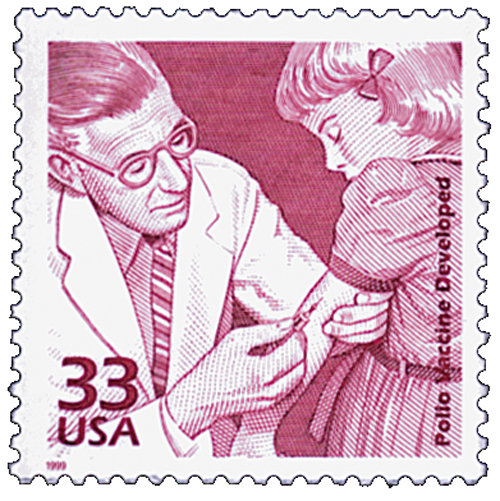
On October 28, 1956, Elvis Presley received a widely publicized polio vaccine that helped to promote the widespread immunization of teenagers around the country.
In 1947, U.S. physician Jonas Salk began research on the polio virus at the University of Pittsburgh School of Medicine. After discovering there were three strains of the virus, he worked to develop a vaccine that would kill each one.
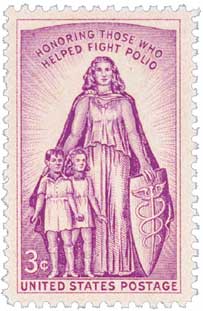
Salk conducted his first field tests in 1952. The vaccine, injected with a needle, was found to reduce the incidence of polio, and was released for use in the U.S. on April 12, 1955. Over the next year, millions of young children received the polio vaccine. However, teenagers, who were also vulnerable to polio, were not getting the vaccine.
Around this same time, Elvis Presley was quickly on his way to becoming one of America’s most famous stars, and was particularly popular among teenagers. Hoping to harness his popularity for this cause, the National Foundation for Infantile Paralysis asked Elvis if he would get the polio vaccine on-camera to help raise awareness and encourage teens to get the vaccine themselves.
Elvis was always glad to help a deserving cause and gladly agreed to join in the promotion. The foundation also called on members of 600 Elvis fan clubs to help promote the event. On October 28, 1956, he was scheduled to appear on The Ed Sullivan Show.
Before the show began, Elvis was filmed and photographed receiving the vaccine. The video played on national television and the photos appeared in newspapers around the country. Elvis also met with March of Dimes poster girl Joanne Wilson. Elvis would continue to promote polio vaccination in the coming years, recording special advocacy messages, and endorsing events aimed at fundraising and awareness.
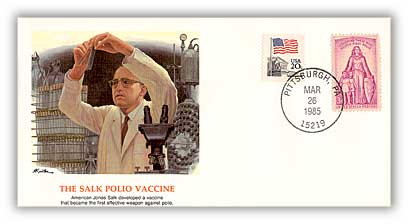
In addition to Elvis’ public vaccine demonstration, the foundation also created Teens Against Polio. These teens went door-to-door to raise awareness, held special dances for vaccinated teens, and more. The foundation also promoted the fundraising efforts of the March of Dimes.
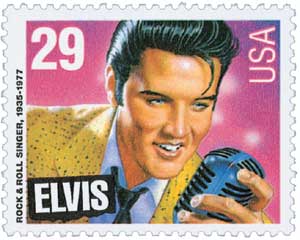
Elvis’ public appearances coupled with the efforts of teens and the March of Dimes all paid off. Immunization levels in the U.S. increased from .6% to over 80% in just six months, and by 1960, instances of polio in the U.S. decreased by almost 90%.
Click here for a neat video about Elvis’ polio awareness campaign.
Dr. Jonas Salk
Jonas Edward Salk was born on October 28, 1914, in New York, New York.
Salk attended the Townsend Harris High School for gifted students and had a reputation for being a perfectionist. He would also read anything he could get his hands on.
From there Salk went on to attend the City College of New York where he earned a degree in chemistry in 1934. He had originally wanted to study law, and claimed he never had an interest in science as a child, but his mother urged him to pursue medicine. Salk then went to New York City Medical School. However, he didn’t want to study medicine, rather he preferred medical research.
Salk soon focused his studies on bacteriology. He stated that he wanted to help humankind as a whole, instead of single patients. Salk was particularly influenced by his time in the laboratory of Thomas Francis, who studied the influenza virus. He helped develop the first effective influenza vaccine, still the basis of the flu vaccinations given today.
After graduating and completing his residency at Mount Sinai Hospital, Salk wanted to run his own lab. In 1947, he received one from the University of Pittsburgh School of Medicine. The following year, he was contacted by the National Foundation for Infantile Paralysis. They wanted him to try to find out of there were more than three types of polio known at the time. Paralytic poliomyelitis, or polio, was the most frightening public health problem facing America after World War II. Each year, thousands of people, mostly children, died or were permanently paralyzed by the disease.
Salk assembled a research team and set up a lab. After extensive study, he decided to turn his attention toward creating a vaccine. At the time, most vaccines use live viruses, which was dangerous. Salk opted for using the safer “killed” virus. He conducted his first field tests in 1952, first on children who had recovered from polio, and later on those who had never had the disease. Both tests were successful, and his findings were published the next year in the Journal of the American Medical Association.
In 1954, tests were done on an even larger scale. The vaccine, injected with a needle, was found to reduce the incidence of polio. On April 12, 1955, it was declared safe and released for use in the US. It was the first effective polio vaccine and was added to the World Health Organization’s List of Essential Medicines. One of Salk’s contemporaries, Dr. Albert Sabin, developed an oral vaccine in 1957 that further helped to eradicate polio in the United States and most countries around the world.
Salk became an international celebrity, but he didn’t like the attention. He also received a presidential citation, the Presidential Medal of Freedom, several foreign and American awards, and four honorary degrees. But Salk wanted to continue his research. He established the Salk Institute for Biological Studies in 1963. He also spent the final chapter of his life researching a vaccine for AIDS. Salk died on June 23, 1995, in La Jolla, California.
Elvis’ Polio Vaccine Raises Immunization Levels

On October 28, 1956, Elvis Presley received a widely publicized polio vaccine that helped to promote the widespread immunization of teenagers around the country.
In 1947, U.S. physician Jonas Salk began research on the polio virus at the University of Pittsburgh School of Medicine. After discovering there were three strains of the virus, he worked to develop a vaccine that would kill each one.

Salk conducted his first field tests in 1952. The vaccine, injected with a needle, was found to reduce the incidence of polio, and was released for use in the U.S. on April 12, 1955. Over the next year, millions of young children received the polio vaccine. However, teenagers, who were also vulnerable to polio, were not getting the vaccine.
Around this same time, Elvis Presley was quickly on his way to becoming one of America’s most famous stars, and was particularly popular among teenagers. Hoping to harness his popularity for this cause, the National Foundation for Infantile Paralysis asked Elvis if he would get the polio vaccine on-camera to help raise awareness and encourage teens to get the vaccine themselves.
Elvis was always glad to help a deserving cause and gladly agreed to join in the promotion. The foundation also called on members of 600 Elvis fan clubs to help promote the event. On October 28, 1956, he was scheduled to appear on The Ed Sullivan Show.
Before the show began, Elvis was filmed and photographed receiving the vaccine. The video played on national television and the photos appeared in newspapers around the country. Elvis also met with March of Dimes poster girl Joanne Wilson. Elvis would continue to promote polio vaccination in the coming years, recording special advocacy messages, and endorsing events aimed at fundraising and awareness.

In addition to Elvis’ public vaccine demonstration, the foundation also created Teens Against Polio. These teens went door-to-door to raise awareness, held special dances for vaccinated teens, and more. The foundation also promoted the fundraising efforts of the March of Dimes.

Elvis’ public appearances coupled with the efforts of teens and the March of Dimes all paid off. Immunization levels in the U.S. increased from .6% to over 80% in just six months, and by 1960, instances of polio in the U.S. decreased by almost 90%.
Click here for a neat video about Elvis’ polio awareness campaign.





